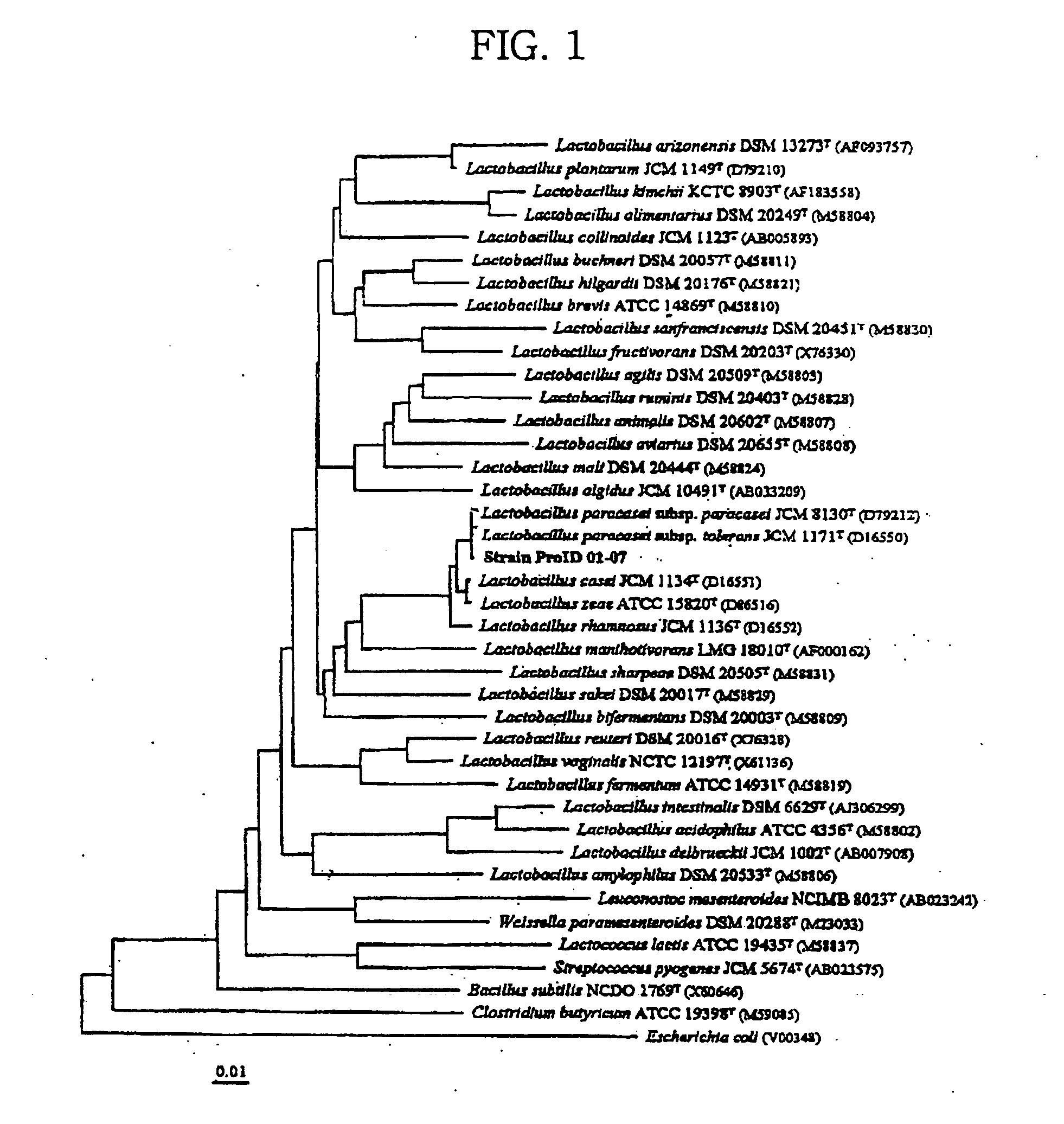Novel lactobacillus sp. strain and use thereof
a technology of lactobacillus and lactobacillus, which is applied in the field of new lactobacillus sp. strains to achieve the effect of superior acid resistan
- Summary
- Abstract
- Description
- Claims
- Application Information
AI Technical Summary
Benefits of technology
Problems solved by technology
Method used
Image
Examples
example 1
[0055] Isolation and Identification of Lactobacillus sp. Strain
[0056] 1-1) Isolation of Lactobacillus sp. Strain from Kimchi
[0057] Chinese cabbage Kimchi was made and fermented at 25° C. for 20 days(pH 4.0±0.2) by traditional method. 1 ml of said fermented Kimchi liquid was serially diluted with sterilized physiological solution to a dilution factor of 101 to 107 and then 0.1 ml of each dilution was inoculated onto BHI(Brain Heart Infusion, Difco, USA) and incubated at 37° C. for 72 hours. Cultured bacterial mass was cultivated in BCP(Brom Cresol Purple) agar medium, a medium for detecting lactic acid whereby color changes from purple to yellow by lactic acid production, and bacterial strains having good lactic acid production were primarily isolated.
[0058] The isolated bacterial strains were Gram stained and observed under microscope to select bacillus strains. After selecting Gram positive bacillus type microorganisms, they were incubated at 30° C. in an incubator for 48 hours ...
example 2
[0065] Characterization of the Lactobacillus paracasei viro-01 of the Present Invention
[0066] 2-1) Acid- and Bile Acid-Resistance Test
[0067]Lactobacillus paracasei viro-01 isolated from the above example 1 was suspended in 0.85% brine with pH 2.0 and 3.0 and incubated at 37° C hourly. The culture was diluted decimally, smeared it MRS medium and the number of colonies was counted. As a result, all the test bacterial strains were grown, and it was confirmed from this that Lactobacillus paracasei viro-01 of the present invention possessed acid-resistance.
[0068] For the bile acid resistance test, bacterial strains were cultured in MRS liquid medium and smeared on MRS agar medium to which 0.2%, 0.3%, 0.5%, 0.7% and 1.0% of Oxgall(Difco) were added, incubated at 37° C. and then checked for growth. It was observed that all bacterial strains grew at Oxgall concentrations below 0.5%.
[0069] 2-2) Determination of Harmful Microorganism-Inhibiting Activity
[0070] It was determined for harmfu...
example 3
[0088] Production of lactic acid bacteria fruit juice fermentation liquid using Lactobacillus paracasei viro-01 of the present invention and safety test for the same
[0089] Fermentation product was prepared using the Lactobacillus paracasei viro-01 of the present invention and it was examined for safety. Said fermentation product was prepared by inoculating the Lactobacillus paracasei viro-01 of the present invention into juice of ripened fruit and fermenting to produce lactic acid bacteria fruit juice fermentation liquid. Lactobacillus paracasei viro-01 of the present invention was inoculated into MRS broth, incubated at 37° C. for 48 hours, 2% of said Lactobacillus paracasei viro-01 was inoculated into mixed fruit juice composed of sterilized apple juice 50%, orange juice 20%, grape juice 20% and jujube juice 10% and then fermented anaerobically at 30° C. Said mixed fruit juice was diluted with purified water to Brix 5 to a brix degree of 5%. After 72 hours, when pH reached 3.0, s...
PUM
| Property | Measurement | Unit |
|---|---|---|
| Temperature | aaaaa | aaaaa |
| Temperature | aaaaa | aaaaa |
| Fraction | aaaaa | aaaaa |
Abstract
Description
Claims
Application Information
 Login to View More
Login to View More - R&D
- Intellectual Property
- Life Sciences
- Materials
- Tech Scout
- Unparalleled Data Quality
- Higher Quality Content
- 60% Fewer Hallucinations
Browse by: Latest US Patents, China's latest patents, Technical Efficacy Thesaurus, Application Domain, Technology Topic, Popular Technical Reports.
© 2025 PatSnap. All rights reserved.Legal|Privacy policy|Modern Slavery Act Transparency Statement|Sitemap|About US| Contact US: help@patsnap.com

